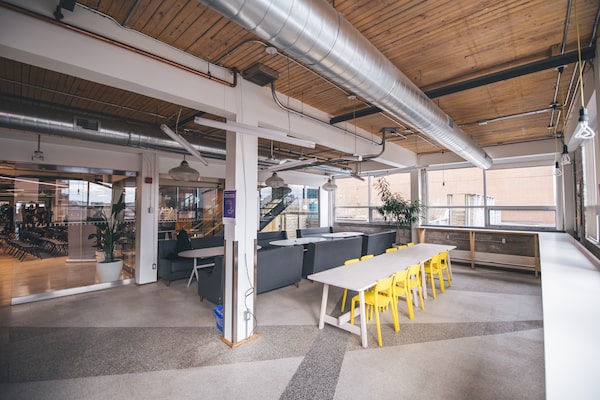
StackAdapt's lunchrooms features long tables to promote more communal eating.stackadapt/Handout
In 2017, StackAdapt, an advertising technology company in Toronto, moved offices to a location that was triple the square footage. The move not only gave it more space, it allowed the company to change its lunchroom setup and improve company culture.
“When you don’t create an inclusive environment, people tend to navigate toward these little cliquey lunch crews,” says Natalia Vassilieva, the company’s director of people and culture.
At StackAdapt’s old office, the lunchroom had a few small separate tables that seated four each. Ms. Vassilieva says it led to higher rates of desk dining and employees leaving the office to eat. In the new lunchroom, two long communal tables allow for better communication between different groups and departments, and employees now make use of the lunchroom more.
According to a survey conducted by grocery brand President’s Choice in 2018, 42 per cent of working Canadians eat lunch alone every day at work. Forty-seven per cent reported feeling sad or envious when eating alone and seeing other people eating together, while 23 per cent say they’re too busy to leave their desks.
At the same time, the latest update to Canada’s Food Guide earlier this year emphasizes the importance of dining together. “Eating with others help to elevate mood, energy and improve self-esteem,” says Billie Jane Hermosura, a registered dietitian based in Ottawa. A 2017 study from the University of Oxford reinforces this, stating that social diners “feel happier and are more satisfied with life, are more trusting of others, are more engaged with their local communities, and have more friends they can depend on for support.”
It’s also not just employees who get a boost from eating with others. Organizations can benefit from buzzing lunchrooms, as a 2015 Cornell University study on firehouses shows. Firehouses where meals were eaten together more often were shown to have improved group performance. A social lunchroom also promotes organic interactions between departments, as it did for StackAdapt.
Ms. Hermosura says there are small things that businesses can do to encourage social lunch hours. Several non-profit and government organizations she has worked with have implemented a “passport” program for promoting lunch activities, such as going for a walk from Point A to Point B or grabbing a co-worker to eat lunch outside. “Each activity had a co-worker’s name on it and they would have to go to that person, do the activity and get a sticker,” she explains.
StackAdapt has also found success with using the “piggyback” feature on Ritual, a mobile-phone dining app that allows users to place orders in advance and simply pick up the meal at the restaurant. The feature allows users to designate one person or employee to bring back multiple food orders.
“That person will have to bring back food for the rest of the office,” says Meredith Murray, the company’s people and culture co-ordinator. “They leave it in the kitchen and there’s usually some type of conversation that happens or they will sit with the person that brought the food back for them.”
Change can also come from the top-down. Ms. Hermosura suggests team leads or chief executives take their teams or groups of employees out for lunch. “By doing it once a week, or once every couple of weeks, that demonstrates the importance of taking a lunch with others.” One thing companies shouldn’t do, however, is ban desk dining outright, according to Ms. Vassilieva.
Instead of targeting individual employees, she promotes change through discussions with team leads. She says she believes managers who eat at their desk are modelling that behaviour for their team and has encouraged those in charge to dine socially.
“You have to start at the very top with your CEO and your founding team,” she says. “Having their buy-in is the most important thing.”
Stay ahead in your career. We have a weekly Careers newsletter to give you guidance and tips on career management, leadership, business education and more. Sign up today.